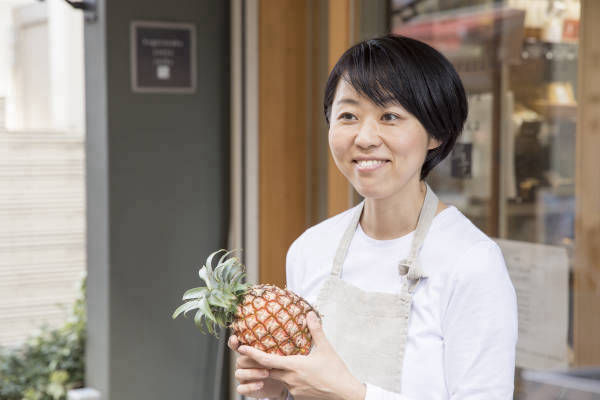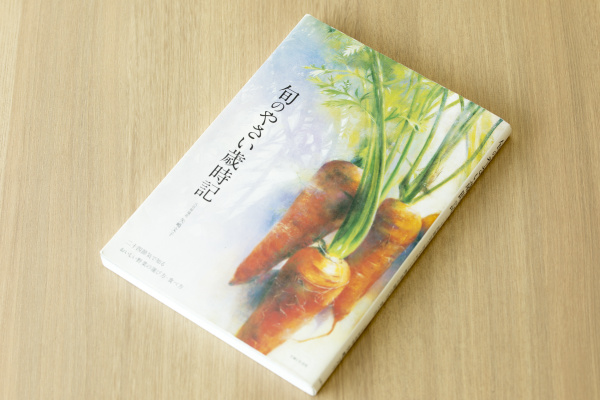Pineapples—Summer’s Fruit

Appetizing and powerfully sweet domestic pineapple

Ayako Yajima, of the fruit and vegetable shop Suika (Kagurazaka, Tokyo/closed in 2019), taught us about the characteristics of domestic pineapples and how to select them.
“Domestic pineapples are in season from around April to August. Most of them are from Okinawa, with a small number from Kagoshima. Pineapples are a type of fruit in which after-ripening is not carried out after harvesting. This means that the fruit at harvest is at the maximum sweetness. Domestic pineapples have a short shipping time, which allows farmers to ripen the fruit to its limit before harvesting, which makes it extremely delicious.”
Unripe fruit contains more calcium oxalate, which causes irritation within the mouth, so fully ripened fruit is much easier to eat. Furthermore, the shelf time after harvest to eating causes the acidity of the fruit to gradually decrease, although no after-ripening is carried out. People who prefer pineapples that are both sweet and tart should look for fresh, domestic pineapples.
Three Okinawan pineapples and their unique features

According to Yajima, there are four major points to consider in selecting pineapples.
・Select fruit that is heavy and full of juices
・Select fruit that is fully ripe and fragrant with the skin intact
・Select fruit in which the dents on the underside are not moldy
・Select fruit that is fresh and firm
Each individual pineapple varies in color, such as yellow and brown, but the color of the skin does not seem to affect the taste of pineapples very much.
“The enzymes found in pineapples regulate intestinal functions, so eating pineapples is highly recommended during the summer when the digestive system tends to get fatigued. Heating pineapples to 60 degrees Celsius or more will break down these enzymes, so eating pineapples raw such as with yogurt or in salads is the best way to go. I often enjoy pineapples in salads with diced carrots, cucumbers and mixed beans, dressed with yogurt,” says Yajima.
Yajima also informed us of the differences between major domestic pineapples.

Shima Pineapples
“The smooth cayenne breed of Hawaiian pineapple is harvested around the world. This breed is also grown in Okinawa and is called Shima pineapples there. This type features a good balance of tartness and sweetness, and is often used in processed pineapple products as well.”

Peach Pineapples
“This type is named Soft Touch, but it is also often called Peach pineapple because of its white flesh, which resembles peaches. This type of pineapple is the result of selective breeding for a stronger sweetness and fragrance.”

Snack Pineapples
“This type is the Bogor pineapple, which originates from Taiwan. It is called ‘snack pineapple’ because it can be torn apart at its ‘nodes’ by hand to eat.

The core is also soft and edible.”
Summer sweets featuring pineapples

Pineapples are delicious eaten on their own. However, we visited sweets researcher marimo to explore even tastier options.
“Fruits with a strong acidity, such as pineapples, blueberries and oranges, can create delicious sweets either raw or cooked. Fruit such as peaches, melons and cherries, which have a milder taste, are recommended raw, and fruit with a richer flavor such as apricots and figs can be heated for delicious results.”
Pineapples have a rich, sweet and tart flavor that is not erased by confectionary ingredients such as butter or cream, making it a perfect fruit for making sweets.

However, pineapples contain proteolytic enzymes, which suppress the functions of gelatin. This is why it is better to heat pineapples when making sweets using gelatin, such as jellies or mousse.
This time, a recipe for refreshing shortcake perfect for early summer has been recommended to us.
A refreshing shortcake, perfect for early summer

Recently the popularity of the “naked shortcake” is rising. The shortcakes are “naked” because they do not feature any cream on the sides of the cake, with the cake layers clearly visible. These cakes are easier for novice bakers to make, as there is no need to spread whipped cream evenly on the surface of the cake.
“The important point for this cake is to have the cake sponge and fruit for filling in even slices. The cake will look more attractive if some of the cream and pineapples can be seen protruding from the sides, in a casual way,” explains marimo.
Arranging the decorative parts on top of the cake like a wreath will also create an endearing result. If you are to make this cake with fruits that contain a lot of moisture such as melons or peaches, thoroughly blot the fruit with paper towels before using it on the cake.
However, pineapples contain proteolytic enzymes, which suppress the functions of gelatin. This is why it is better to heat pineapples when making sweets using gelatin, such as jellies or mousse.
A sweets recipe that looks refreshing, perfect for early summer.
How about using domestic pineapples this year, and challenging yourself to make this cake?












